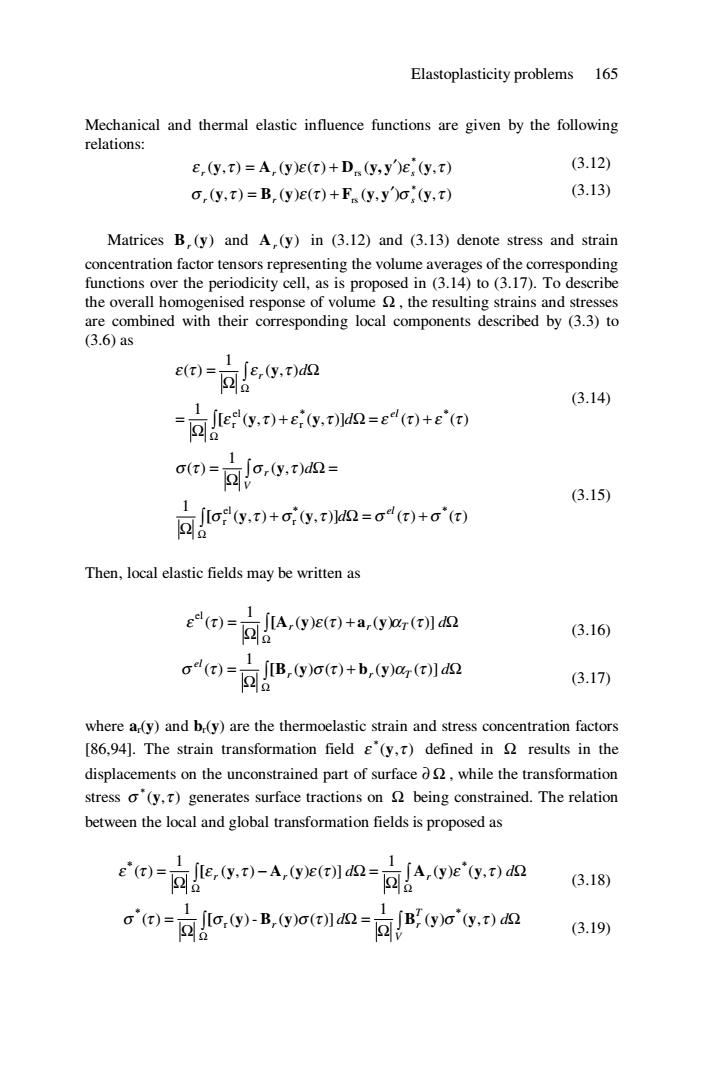正在加载图片...

Elastoplasticity problems 165 Mechanical and thermal elastic influence functions are given by the following relations: e,(,t)=A,(y)e(t)+D.(,ye(y,t) (3.12) o,(y,t)=B,(y)e(T)+F (y,yo;(y,t) (3.13) Matrices B,(y)and A,(y)in (3.12)and (3.13)denote stress and strain concentration factor tensors representing the volume averages of the corresponding functions over the periodicity cell,as is proposed in(3.14)to (3.17).To describe the overall homogenised response of volume the resulting strains and stresses are combined with their corresponding local components described by (3.3)to (3.6)as E(T)= e,n (3.14) =可。e.t0+ekn=e4a+ea oo)=回Jo,.ta2= (3.15) 司aic.t+dict-oo+oio Then,local elastic fields may be written as e4(t)= Aoem+aggaln (3.16) 1 o=可B,0ae+b,a,e1 (3.17) where a(y)and b(y)are the thermoelastic strain and stress concentration factors [86,94].The strain transformation field (y,t)defined in results in the displacements on the unconstrained part of surface o,while the transformation stress o(y,t)generates surface tractions on being constrained.The relation between the local and global transformation fields is proposed as e'(= le,)-Aeon= A,0e.a (3.18) oio=时a,-B,ao1n=向sain (3.19)Elastoplasticity problems 165 Mechanical and thermal elastic influence functions are given by the following relations: ( , ) ( ) ( ) ( ) ( , ) * rs ε y τ A y ε τ D y, y ε y τ r r s = + ′ (3.12) ( , ) ( ) ( ) ( , ) ( , ) * rs σ y τ B y ε τ F y y σ y τ r r s = + ′ (3.13) Matrices ) B (y r and ) A (y r in (3.12) and (3.13) denote stress and strain concentration factor tensors representing the volume averages of the corresponding functions over the periodicity cell, as is proposed in (3.14) to (3.17). To describe the overall homogenised response of volume Ω , the resulting strains and stresses are combined with their corresponding local components described by (3.3) to (3.6) as ( , ) ( , )] ( ) ( ) 1 ( , ) 1 ( ) * * r el r ε τ ε τ ε τ ε τ ε τ ε τ + Ω = + Ω = Ω Ω = ∫ ∫ Ω Ω el r d d [ y y y (3.14) ( , ) ( , )] ( ) ( ) 1 ( , ) 1 ( ) * * r el r σ τ σ τ σ τ σ τ σ τ σ τ + Ω = + Ω Ω = Ω = ∫ ∫ Ω el V r d d [ y y y (3.15) Then, local elastic fields may be written as + Ω Ω = ∫ Ω r ( ) ( ) r ( ) T ( )] d 1 ( ) el ε τ [A y ε τ a y α τ (3.16) ∫ Ω + Ω Ω = r r T d el ( ) ( ) ( ) ( )] 1 σ (τ ) [B y σ τ b y α τ (3.17) where ar(y) and br(y) are the thermoelastic strain and stress concentration factors [86,94]. The strain transformation field ) ( , * ε y τ defined in Ω results in the displacements on the unconstrained part of surface ∂ Ω , while the transformation stress ) ( , * σ y τ generates surface tractions on Ω being constrained. The relation between the local and global transformation fields is proposed as ∫ ∫ Ω Ω Ω Ω − Ω = Ω = r r d r ( ) ( , ) d 1 ( , ) ( ) ( )] 1 ( ) * ε τ [ε y τ A y ε τ A y ε y τ * (3.18) ∫ ∫ Ω Ω Ω = Ω = Ω V T r d r ( ) ( , ) d 1 ( ) - ( ) ( )] 1 ( ) * r * σ τ [σ y B y σ τ B y σ y τ (3.19)